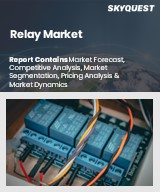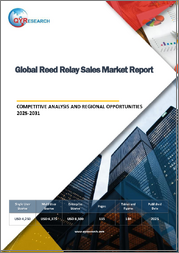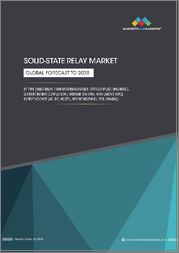
|
시장보고서
상품코드
1630734
타이밍 릴레이 시장 규모, 점유율, 성장 분석 : 타이머 유형별, 기능 유형별, 최종사용자별, 용도별, 지역별 - 산업 예측(2025-2032년)Timing Relay Market Size, Share, Growth Analysis, By Timer Type (On-Delay Timer, Off-Delay Timer), By Function Type (Single Function, Multi-Function), By End-User, By Application, By Region - Industry Forecast 2025-2032 |
||||||
세계의 타이밍 릴레이 시장 규모는 2023년에 5억 9,002만 달러로 평가되며, 예측 기간(2025-2032년)의 CAGR은 5.5%로 성장하며, 2024년 6억 2,247만 달러에서 2032년에는 9억 5,530만 달러로 성장할 전망입니다.
산업 자동화 분야의 중요한 컴포넌트인 타이밍 릴레이 세계 시장은 다양한 산업에서 시간 관리와 업무 효율성을 크게 향상시킵니다. 이 시장은 자동화, 기술 발전, 에너지 효율이 높은 솔루션으로의 전환을 중시하는 경향이 강화되면서 지속적으로 성장하고 있습니다. 디지털 기술, 자동화, 데이터 분석이 결합된 인더스트리 4.0의 출현으로 보다 스마트한 타이밍 릴레이 시스템이 요구되고 있습니다. 최신 릴레이는 현재 프로그래밍이 가능하고 네트워크화된 데이터 중심 기능을 제공하며 스마트 제조 생태계에 원활하게 통합되어 있습니다. 원격 모니터링, 실시간 조정, 예지보전, 데이터베이스 분석과 같은 기능을 통해 제조업체는 경쟁이 치열해지는 상황에서 생산성과 유연성, 대응력을 높일 수 있습니다. 이러한 진화는 미래의 제조 공정에서 타이밍 릴레이의 중요한 역할을 강조하고 있습니다.
목차
서론
- 조사의 목적
- 조사 범위
- 정의
조사 방법
- 정보 조달
- 2차 데이터와 1차 데이터 방법
- 시장 규모 예측
- 시장의 전제조건과 제한
개요
- 세계 시장 전망
- 공급과 수요의 동향 분석
- 부문별 기회 분석
시장 역학과 전망
- 시장 개요
- 시장 규모
- 시장 역학
- 촉진요인과 기회
- 억제요인과 과제
- Porter의 산업 분석
주요 시장 인사이트
- 주요 성공 요인
- 경쟁의 정도
- 주요 투자 기회
- 시장 에코시스템
- 시장의 매력 지수(2024년)
- PESTEL 분석
- 거시경제 지표
- 밸류체인 분석
- 가격 분석
- 사례 연구
- 기술의 진보
- 규제 상황
- 특허 분석
타이밍 릴레이 시장 규모 : 타이머 유형별
- 시장 개요
- 온 딜레이 타이머
- 오프 딜레이 타이머
- 원샷 타이머
- 플래시 타이머
- 기타
타이밍 릴레이 시장 규모 : 기능 유형별
- 시장 개요
- 단일 기능
- 다기능
타이밍 릴레이 시장 규모 : 최종사용자별
- 시장 개요
- 유틸리티용
- 산업용
- 상업용
- 주택용
타이밍 릴레이 시장 규모 : 용도별
- 시장 개요
- 발전
- 석유 및 가스
- 자동차
- 화학·석유화학
- 물과 폐수
- 기타
타이밍 릴레이 시장 규모
- 북미
- 미국
- 캐나다
- 유럽
- 독일
- 스페인
- 프랑스
- 영국
- 이탈리아
- 기타 유럽 지역
- 아시아태평양
- 중국
- 인도
- 일본
- 한국
- 기타 아시아태평양
- 라틴아메리카
- 브라질
- 기타 라틴아메리카 지역
- 중동 및 아프리카
- GCC 국가
- 남아프리카공화국
- 기타 중동 및 아프리카
경쟁 정보
- 상위 5사의 비교
- 주요 기업의 시장 포지셔닝(2024년)
- 주요 시장 기업이 채택한 전략
- 시장의 최근 동향
- 기업의 시장 점유율 분석(2024년)
- 주요 기업의 기업 개요
- 회사 개요
- 제품 포트폴리오 분석
- 부문별 점유율 분석
- 매출의 전년대비 비교(2022-2024년)
주요 기업 개요
- ABB Ltd.(Switzerland)
- Siemens AG(Germany)
- Schneider Electric SE(France)
- Eaton Corporation(Ireland)
- Omron Corporation(Japan)
- TE Connectivity Ltd.(Switzerland)
- Phoenix Contact GmbH & Co. KG(Germany)
- Finder S.p.A.(Italy)
- Comat Releco AG(Switzerland)
- Geya Electrical Equipment Co., Ltd.(China)
- Audiotronics(USA)
- JVS Electronics Pvt. Ltd.(India)
- Honeywell International Inc.(USA)
- Rockwell Automation, Inc.(USA)
- Panasonic Corporation(Japan)
- Littelfuse, Inc.(USA)
- Weidmuller Interface GmbH & Co. KG(Germany)
결론과 권장사항
KSA 25.02.13Global Timing Relay Market size was valued at USD 590.02 million in 2023 and is poised to grow from USD 622.47 million in 2024 to USD 955.3 million by 2032, growing at a CAGR of 5.5% during the forecast period (2025-2032).
The global timing relay market, a vital component of the industrial automation sector, significantly enhances time management and operational efficiency across diverse industries. Growing consistently, this market is fueled by the increasing emphasis on automation, technological advancements, and a shift toward energy-efficient solutions. The emergence of Industry 4.0, marked by the convergence of digital technologies, automation, and data analytics, necessitates smarter timing relay systems. Modern relays now offer programmable, networked, and data-centric functionalities, integrating seamlessly into smart manufacturing ecosystems. They enable features such as remote monitoring, real-time adjustments, predictive maintenance, and data-driven analytics, empowering manufacturers to boost productivity, flexibility, and responsiveness in an increasingly competitive landscape. This evolution underscores the critical role of timing relays in tomorrow's manufacturing processes.
Top-down and bottom-up approaches were used to estimate and validate the size of the Global Timing Relay market and to estimate the size of various other dependent submarkets. The research methodology used to estimate the market size includes the following details: The key players in the market were identified through secondary research, and their market shares in the respective regions were determined through primary and secondary research. This entire procedure includes the study of the annual and financial reports of the top market players and extensive interviews for key insights from industry leaders such as CEOs, VPs, directors, and marketing executives. All percentage shares split, and breakdowns were determined using secondary sources and verified through Primary sources. All possible parameters that affect the markets covered in this research study have been accounted for, viewed in extensive detail, verified through primary research, and analyzed to get the final quantitative and qualitative data.
Global Timing Relay Market Segmental Analysis
Global Timing Relay Market is segmented by Timer Type, Function Type, End-User, Application and region. Based on Timer Type, the market is segmented into On-Delay Timer, Off-Delay Timer, One-Shot Timer, Flasher Timer and Others. Based on Function Type, the market is segmented into Single Function and Multi-Function. Based on End-User, the market is segmented into Utilities, Industrials, Commercial and Residential. Based on Application, the market is segmented into Power Generation, Oil & Gas, Automotive, Chemical & Petrochemical, Water & Wastewater and Others. Based on region, the market is segmented into North America, Europe, Asia Pacific, Latin America and Middle East & Africa.
Driver of the Global Timing Relay Market
The global Timing Relay market is primarily driven by the rising technical and commercial demand across various sectors. These relays play a crucial role in control, startup, and safety circuits, offering time-delay functionalities that are vital for efficient operations. Their compact design makes them especially suitable for industrial applications like control cabinets, switchgear, and control systems. Additionally, the growing commercial real estate sector leads to increased reliance on systems such as air conditioning, elevators, and lighting, all of which require precise timing for safe operation. As the need for mechanical devices persists in numerous industries and wide lag times become commonplace, the demand for timing relays is expected to surge throughout the forecast period.
Restraints in the Global Timing Relay Market
The Global Timing Relay Market faces certain constraints primarily due to stringent safety and compliance regulations across various sectors. Industries such as chemical processing, oil and gas, and power generation are especially impacted, as safety remains paramount in environments where accidents can lead to severe repercussions. Compliance with safety standards is crucial, and transit time is commonly employed to evaluate safety protocols and emergency shutdown systems, ensuring prompt critical actions during abnormal or hazardous situations. Consequently, these rigorous safety and compliance requirements, while essential for protecting human life and property, may also hinder the market's growth and flexibility in certain instances.
Market Trends of the Global Timing Relay Market
The global timing relay market is witnessing a significant upward trend driven by the increasing focus on energy efficiency across various industries. Businesses are actively seeking solutions to minimize their energy consumption and environmental impacts, leading to the adoption of timing relays as essential tools for achieving these objectives. These devices facilitate optimal energy management, as seen in applications like automated lighting systems that turn on and off at predetermined intervals and HVAC systems that regulate operational cycles. The growing global emphasis on sustainability and cost reduction further propels this trend, compelling enterprises to leverage timing relays to lower carbon footprints and enhance operational efficiency.
Table of Contents
Introduction
- Objectives of the Study
- Scope of the Report
- Definitions
Research Methodology
- Information Procurement
- Secondary & Primary Data Methods
- Market Size Estimation
- Market Assumptions & Limitations
Executive Summary
- Global Market Outlook
- Supply & Demand Trend Analysis
- Segmental Opportunity Analysis
Market Dynamics & Outlook
- Market Overview
- Market Size
- Market Dynamics
- Drivers & Opportunities
- Restraints & Challenges
- Porters Analysis
- Competitive rivalry
- Threat of substitute
- Bargaining power of buyers
- Threat of new entrants
- Bargaining power of suppliers
Key Market Insights
- Key Success Factors
- Degree of Competition
- Top Investment Pockets
- Market Ecosystem
- Market Attractiveness Index, 2024
- PESTEL Analysis
- Macro-Economic Indicators
- Value Chain Analysis
- Pricing Analysis
- Case Studies
- Technology Advancement
- Regulatory Landscape
- Patent Analysis
Global Timing Relay Market Size by Timer Type & CAGR (2025-2032)
- Market Overview
- On-Delay Timer
- Off-Delay Timer
- One-Shot Timer
- Flasher Timer
- Others
Global Timing Relay Market Size by Function Type & CAGR (2025-2032)
- Market Overview
- Single Function
- Multi-Function
Global Timing Relay Market Size by End-User & CAGR (2025-2032)
- Market Overview
- Utilities
- Industrials
- Commercial
- Residential
Global Timing Relay Market Size by Application & CAGR (2025-2032)
- Market Overview
- Power Generation
- Oil & Gas
- Automotive
- Chemical & Petrochemical
- Water & Wastewater
- Others
Global Timing Relay Market Size & CAGR (2025-2032)
- North America (Timer Type, Function Type, End-User, Application)
- US
- Canada
- Europe (Timer Type, Function Type, End-User, Application)
- Germany
- Spain
- France
- UK
- Italy
- Rest of Europe
- Asia Pacific (Timer Type, Function Type, End-User, Application)
- China
- India
- Japan
- South Korea
- Rest of Asia-Pacific
- Latin America (Timer Type, Function Type, End-User, Application)
- Brazil
- Rest of Latin America
- Middle East & Africa (Timer Type, Function Type, End-User, Application)
- GCC Countries
- South Africa
- Rest of Middle East & Africa
Competitive Intelligence
- Top 5 Player Comparison
- Market Positioning of Key Players, 2024
- Strategies Adopted by Key Market Players
- Recent Developments in the Market
- Company Market Share Analysis, 2024
- Company Profiles of All Key Players
- Company Details
- Product Portfolio Analysis
- Company's Segmental Share Analysis
- Revenue Y-O-Y Comparison (2022-2024)
Key Company Profiles
- ABB Ltd. (Switzerland)
- Company Overview
- Business Segment Overview
- Financial Updates
- Key Developments
- Siemens AG (Germany)
- Company Overview
- Business Segment Overview
- Financial Updates
- Key Developments
- Schneider Electric SE (France)
- Company Overview
- Business Segment Overview
- Financial Updates
- Key Developments
- Eaton Corporation (Ireland)
- Company Overview
- Business Segment Overview
- Financial Updates
- Key Developments
- Omron Corporation (Japan)
- Company Overview
- Business Segment Overview
- Financial Updates
- Key Developments
- TE Connectivity Ltd. (Switzerland)
- Company Overview
- Business Segment Overview
- Financial Updates
- Key Developments
- Phoenix Contact GmbH & Co. KG (Germany)
- Company Overview
- Business Segment Overview
- Financial Updates
- Key Developments
- Finder S.p.A. (Italy)
- Company Overview
- Business Segment Overview
- Financial Updates
- Key Developments
- Comat Releco AG (Switzerland)
- Company Overview
- Business Segment Overview
- Financial Updates
- Key Developments
- Geya Electrical Equipment Co., Ltd. (China)
- Company Overview
- Business Segment Overview
- Financial Updates
- Key Developments
- Audiotronics (USA)
- Company Overview
- Business Segment Overview
- Financial Updates
- Key Developments
- JVS Electronics Pvt. Ltd. (India)
- Company Overview
- Business Segment Overview
- Financial Updates
- Key Developments
- Honeywell International Inc. (USA)
- Company Overview
- Business Segment Overview
- Financial Updates
- Key Developments
- Rockwell Automation, Inc. (USA)
- Company Overview
- Business Segment Overview
- Financial Updates
- Key Developments
- Panasonic Corporation (Japan)
- Company Overview
- Business Segment Overview
- Financial Updates
- Key Developments
- Littelfuse, Inc. (USA)
- Company Overview
- Business Segment Overview
- Financial Updates
- Key Developments
- Weidmuller Interface GmbH & Co. KG (Germany)
- Company Overview
- Business Segment Overview
- Financial Updates
- Key Developments



















